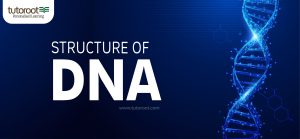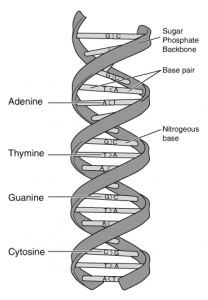What is DNA? – Functions, Structure, Types
DNA is present in all living organisms, and it is very important for the evolution of the said species into future generations, by storing important characteristics and other traits data of the species. Thus, for the students to understand the genetic evolution of various species, it is important to first have a good understanding of the DNA, its functions, general structure, different types, and many more.
What is DNA?
DNA is defined as a group of molecules that play a major role in transferring and storing all the hereditary materials and genetic information from one generation to another generation. Besides, this DNA also plays an active role in the production of proteins in cells.

Furthermore, DNA is also present in the viruses, but it is only available to certain viruses, while the remaining viruses include RNA. DNA’s full form is Deoxyribonucleic acid, and it is found in both prokaryotic and eukaryotic cells. And lastly, DNA is differentiated into multiple types, based on the type of structure or pattern.
Types of DNA
- A-DNA – This type of DNA is formed due to the process of Desiccation, which happens during extreme conditions when the solvent is extracted from the DNA.
- B-DNA – A right-handed helix structure DNA, that is very common, and it is commonly formed under physiological conditions.
- Z-DNA – A different type of DNA, where double helix structure inkling towards the left is observed, and it is said to be playing an active role in gene regulation, due to its location at the start site of the gene.
Structure of DNA

Here in this section, we are going to talk about DNA structure, and label its DNA Components. And as you can see from the picture, it consists of many components such as Adenine, Guanine, Thymine, Cytosine, and Phosphate Backbone. All the nitrogen bases, and the backbone, help in the linking of nucleotides, that form the strand of DNA.
Functions of DNA
From the above sections, as you can guess DNA is a very important part of the cell, and it performs various functions, such as,
- DNA Therapy – In order to treat or prevent diseases related to genetic problems, DNA therapy is essential.
- DNA Replication – As you can understand from the name, in this process, genetic information, as well as an equal number of DNA molecules are transferred from parent cells to daughter cells.
- DNA Transcription – The process of copying a DNA strand into the molecule of messenger RNA is called DNA transcription.
- DNA Mutations – When changes occur in the DNA sequences, they are referred to as Mutations.
- DNA Fingerprinting – The process of identifying or finding a DNA pattern of an individual is called DNA Fingerprinting.
- Cellular Metabolism – In a cell, various types of chemical reactions take place, in order to sustain or maintain life, and this process is defined as Cellular Metabolism.
Conclusion
In the above article, we have provided a comprehensive description of DNA structure, DNA functions, DNA model, DNA components, DNA types, and many more. And if you do have any doubts, or questions about any other chapters or topics, then it is better to join an online coaching platform, which will provide expert staff and guidance, in helping the students understand the subject better, and score good marks in the exams. And currently, Tutoroot is offering Online Home Tutor programs for cost-effective prices, with various amazing features.
Frequently Asked Questions
What is Chargaff’s Rule?
This law states that all organisms must contain a ratio of 1:1, for the number of purine and pyrimidine bases in DNA.
What is the Full Form of DNA?
The full form of DNA is Deoxyribonucleic acid.
What is DNA Replication?
As explained above, DNA Replication involves the transfer of an equal number of DNA molecules, and genetic information from the parent cells to the daughter cells.
